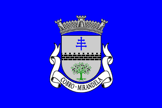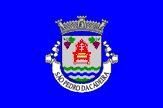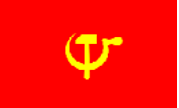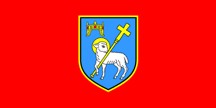


Flag of Cobro, Portugal (fotw);
Flag of Binn, Switzerland (fotw);
Flag of São Pedro da Cadeira, Portugal (fotw)
![[parade flag example]](../images/v/vxt-d2296.gif)
![[parade flag example]](../images/v/vxt-d1150.gif)
Parade Flag of the Royal Naval Association, UK (Graham Bartram); Parade Flag of the Royal British Legion, UK (Graham Bartram)
Notes
a) There are basically three ways
involving a sleeve by which a parade flag or military colour may be affixed to
its staff - with decorative nails (often a precisely regulated number of nails),
by means of a grommet and clip, or by tab and screw (see also
‘grommet’, 'nails'
‘sleeve 2)’ and
‘tab’) however:
b)
The practice of tying a colour/parade flag to its staff, or attaching it by cloth loops or metal rings
is still occasionally seen (see also ‘grommet’,
‘sleeve 2)’, 'tab'
and ‘ties’).
2) In heraldry see ‘counterchanged’.
![[Parti-coloured example]](../images/v/vxt-d1176.gif)
![[Parti-coloured example]](../images/v/vxt-d4832.gif)
![[Parti-coloured example]](../images/v/vxt-d3601.gif)
Flag of Los Labores, Spain (fotw);
Flag of Gelterfingen, Switzerland (fotw);
Flag of Barnim, Germany (fotw)
![[Partially covered example]](../images/v/vxt-d2019.gif)
![[Partially covered example]](../images/v/vxt-d1976.gif)
Flag of Vista Alegre do Alto, Brazil (fotw);
Flag of Maranhão, Brazil (fotw)
Please note that this term is never used alone but always with the number of stripes being covered and/or partially covered.
![[party example]](../images/v/vxt-d1368a.gif)
![[party example]](../images/v/vxt-d1368b.gif)
![[party example]](../images/v/vxt-d1368c.gif)
![[party example]](../images/v/vxt-d1368d.gif)
![[party example]](../images/v/vxt-d1368e.gif)
Party Per Fess, Per Pale, Per Bend, Per Bend Sinister and Per Saltire
Nots
a) This term is never used alone, but always with the term describing the
direction of any such division, for example party per fess.
b) The term “parted” as given in the heading above is not (at the present time) an established heraldic term but is much used on fotw.

A Flag of the
Communist Party, Iraq (fotw)


Flag and Arms of Knin, Croatia (fotw)
![[passant]](../images/v/vxt-d1075.gif)
![[example of passant]](../images/v/vxt-d4595.gif)
![[passant]](../images/v/vxt-d3995.gif)
Flag of Košařiska, Czechia (fotw);
Flag of Marnitz, Germany (fotw); Flag of West-Friesland c1720, The Netherlands (fotw)
![[passant guardant]](../images/v/vxt-d2813.gif)
![[passant guardant]](../images/v/vxt-d5328.gif)
![[passant guardant]](../images/v/vxt-d2814.gif)
Royal Standard of England 1198 – 1340 (fotw);
Flag of Maidstone, UK (fotw);
Flag of Häggenschwil, Switzerland (fotw)
![[pastoral staff]](../images/v/vxt-d3997.gif)
Flag of Basel, Switzerland (fotw)
2) A flag which illustrates the unity and/or ethnic mix of an area’s population by displaying a combination of the appropriate images.
3) See ‘combined flag’.
![[patchwork flag]](../images/v/vxt-d1348.gif)
![[patchwork flag]](../images/v/vxt-d3710.gif)
![[patchwork flag]](../images/v/vxt-d3771.gif)
Example of a EU Patchwork Flag (fotw);
Flag of Kiel, US (fotw); Combined Flag c1914 -
Standard of the Allies (fotw)
![[cross of Lorraine]](../images/v/vxt-d4068.gif)
Flag of Wallbach, Switzerland (fotw)
![[cross pattee]](../images/v/vxt-d3753.gif)
![[cross pattee]](../images/v/vxt-d1903.gif)
Arms of Rzeszów, Poland (fotw); House flag of the Companhia Nacional de Navegação Costeira, Brazil (fotw)
![[pavilion]](../images/v/vxt-d1652.gif)
![[pavilion]](../images/v/vxt-d5186.gif)
![[pavilion]](../images/v/vxt-d2260.gif)
Royal Arms of Egypt 1922 – 1953 (fotw);
Greater Arms/Presidential Flag of Serbia until 2011 (fotw);
Royal Arms of Sweden (fotw)
Notes
a) This term is derived from the “pavise” which was a large shield behind which crossbowmen sheltered whilst reloading – see ‘crossbow’,
b) The practice of hanging shields along the sides of a fighting ship began as a defensive measure but had become largely decorative by the mid-16th Century.
![[Bartloming]](../images/v/vxt-d238a.gif)
![[Kiltai]](../images/v/vxt-d238b.gif)
![[Customs Service, China 1881]](../images/v/vxt-d238c.gif)
Flags of
Bartloming and
Kiltai, Indonesia
c1900 (fotw); Flag of the Customs Service, China 1881 (fotw)
Please note that the Editors have introduced an extension of this term, as no accurate and/or established alternative could be found to cover the Oriental examples.
Please note, it is the tradition in some navies that a ship on her final voyage, or at the end of an extended deployment out of home waters, should fly a special pennant the length of which is commensurate with the length of her last commission, or of the deployment being completed.

![[Flag of truce]](../images/v/vxt-d1170.gif)
![[pavisade]](../images/v/vxt-d237.gif)
![[Paying off pennant]](../images/v/vxt-d1616.gif)